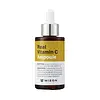What's inside
What's inside
 Key Ingredients
Key Ingredients

 Benefits
Benefits

 Concerns
Concerns

 Ingredients Side-by-side
Ingredients Side-by-side

Water
Skin ConditioningSodium Ascorbyl Phosphate 10%
AntioxidantIsopentyldiol
Humectant1,2-Hexanediol
Skin ConditioningNiacinamide
SmoothingDipropylene Glycol
HumectantButylene Glycol
HumectantMalpighia Emarginata Fruit Extract
Skin ConditioningCitrus Unshiu Peel Extract
MaskingCitrus Aurantifolia Fruit Extract
Skin ConditioningCitrus Limon Fruit Extract
MaskingBrassica Oleracea Italica Extract
AstringentHippophae Rhamnoides Extract
MaskingCitrus Aurantium Dulcis Fruit Extract
MaskingCitrus Paradisi Fruit Extract
Skin ConditioningAscorbic Acid
AntioxidantCitric Acid
BufferingOctyldodeceth-16
EmulsifyingXanthan Gum
EmulsifyingCitrus Aurantium Bergamia Fruit Oil
MaskingSodium Metabisulfite
AntioxidantEthylhexylglycerin
Skin ConditioningCoptis Japonica Extract
AntimicrobialDextrin
AbsorbentTheobroma Cacao Extract
Skin ConditioningSodium Hyaluronate
HumectantTocopheryl Acetate
AntioxidantPanthenol
Skin ConditioningDisodium EDTA
Limonene
PerfumingLinalool
PerfumingWater, Sodium Ascorbyl Phosphate 10%, Isopentyldiol, 1,2-Hexanediol, Niacinamide, Dipropylene Glycol, Butylene Glycol, Malpighia Emarginata Fruit Extract, Citrus Unshiu Peel Extract, Citrus Aurantifolia Fruit Extract, Citrus Limon Fruit Extract, Brassica Oleracea Italica Extract, Hippophae Rhamnoides Extract, Citrus Aurantium Dulcis Fruit Extract, Citrus Paradisi Fruit Extract, Ascorbic Acid, Citric Acid, Octyldodeceth-16, Xanthan Gum, Citrus Aurantium Bergamia Fruit Oil, Sodium Metabisulfite, Ethylhexylglycerin, Coptis Japonica Extract, Dextrin, Theobroma Cacao Extract, Sodium Hyaluronate, Tocopheryl Acetate, Panthenol, Disodium EDTA, Limonene, Linalool
 Reviews
Reviews

Alternatives
Ingredients Explained
These ingredients are found in both products.
Ingredients higher up in an ingredient list are typically present in a larger amount.
Ascorbic Acid is is pure Vitamin C. This form makes up the largest amount of vitamin C found naturally in our skin.
Not only is vitamin C great for your overall health and immune system, it also has plenty of benefits on your skin.
Vitamin C is best used for brightening skin. It improves dark spots, acne scars, and hyperpigmentation. This is because it blocks the process of skin darkening when exposed to UV.
Remember: Vitamin C should not replace sunscreen!
Your skin uses vitamin C to build collagen. Collagen is one key component in having a strong skin barrier and plump skin. Vitamin C also plays a role in regulating collagen, thus making it effective in improving wrinkles and fine lines.
Ascorbic acid shows potent antioxidant activity. As an antioxidant, it helps fight free-radicals. Free-radicals are molecules that may damage your skin cells. These antioxidants also protect skin against UV damage.
The best formulations include Vitamin E and/or ferulic acid. These two ingredients help stabilize and provide a boost in the benefits of ascorbic acid. This is because ascorbic acid becomes unstable when exposed to UV and air. In fact, you can tell your ascorbic acid has oxidized when it turns an orange-yellow color.
Ascorbic acid is generally compatible with other ingredients. However, using ascorbic acid with other active ingredients might cause irritation. Two ingredients: copper ions and benzoyl peroxide, will inactivate ascorbic acid completely.
Read more about other types of Vitamin C:
Foods rich with vitamin C include oranges, strawberries, broccoli, bell peppers, and more. When consuming Vitamin C, your skin receives a portion of the nutrients.
Learn more about Ascorbic AcidLimonene is a fragrance that adds scent and taste to a formulation.
It's found in the peel oil of citrus fruits and other plants such as lavender and eucalyptus. The scent of limonene is generally described as "sweet citrus".
Limonene acts as an antioxidant, meaning it helps neutralize free radicals.
When exposed to air, oxidized limonene may sensitize the skin. Because of this, limonene is often avoided by people with sensitive skin.
The term 'fragrance' is not regulated in many countries. In many cases, it is up to the brand to define this term. For instance, many brands choose to label themselves as "fragrance-free" because they are not using synthetic fragrances. However, their products may still contain ingredients such as essential oils that are considered a fragrance.
Learn more about Limonene